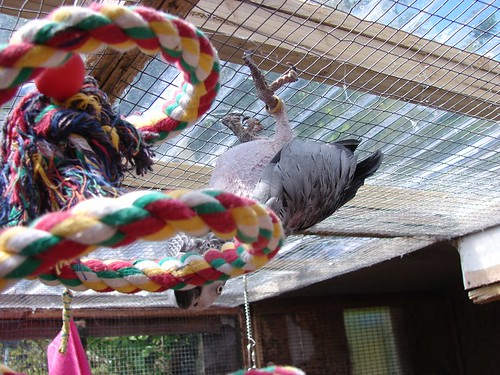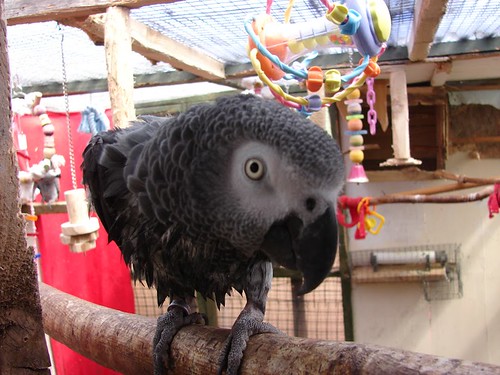Energy is very important to parrots and how they react to us. Our birds can sense our every mood change, reading both your body language and the way you look to them in UV. They can perceive many more colours than we can, and – as the Island Parrot Sanctuary once put it to me – because of that, they know you better than you know yourself. They can see your mood.
One of the things I try and do with new or nervous owners is show them how their energy can affect their bird. If you go into a training session with anxiety, your bird picks up on this. He notices and wonders what’s wrong, making him more likely to react negatively. After all, you’ve accidentally put him on edge.
By outwardly acting cool and collected – even if you’re not inside – you can help your bird feel safer and calm down.
There are four main instances where energy is an important tool to use:
- When training. Don’t go into a training session with any kind of residual negative energy. Training is a time for enjoyment, and a parrot needs to see your trust in order to trust you.
- When dealing with an aggressive parrot. A bird who knows you are afraid will strike because it doesn’t know what else to do. By making you go away, it will be able to relax. Learn to fake this – it’s kind of like being a performer! You don’t show the audience how scared you are when you go on stage, no matter what it takes. Eventually, you will actually relax into your own performance.
- When working with an abused, sick, or feather-destructive parrot. A bird can sense when you’re feeling pity, sadness, or anxiety. If you react with these things, the animal will pick up on it, turning those emotions inward in a vicious cycle. The IPS once told me that they can’t open to the public quite the way they used to because strangers would walk through the aviaries pointing and reacting with alarm. The birds were aware of this – and would become upset. They saw people looking at them this way, and felt anxiety because of it. Even if you want to feel pity for a plucked parrot, put a positive spin on it. He has a good life now.
- When going through your daily routine. Surrounding your bird with positive energy sounds very new-agey, but it works. A bird is built to react to everyone around it. They survive in the wild by being completely attuned to both their flock and their environment. You can turn this on its head by lowering your own heart rate through deep breathing, speaking in a calm, low voice, and trying to ‘emanate’ real confidence and happiness.
If you want to know how to use your energy in a positive way, it’s easy to begin. Deep breathing will lower your heart rate. Let everything go. If you’re nervous or afraid, fake it by adjusting your body language. This is as simple as squaring your shoulders, looking directly ahead, and moving confidently. Don’t shy away from the bird. Move slowly and deliberately, and ignore your fear. Breathe.
Fake being confident long enough, and it will come naturally.
For owners who are scared of their pet, if everything gets to be too much, don’t try to handle him. Just quietly, calmly remove yourself from the room for a moment. Try and relax by breathing or stretching through your nerves. When you’re feeling ready, head back in. Projecting good energy goes a long way towards calming many birds down.
I asked once how the owner of the sanctuary could work with any parrot and not be afraid. After all, some can be very unpredictable and dangerous. She replied that of course she gets nervous sometimes, but she isn’t going to let a bird know that. By projecting quiet confidence with aggressive birds, and gentle reassurance with phobic ones, she prevents a bite most of the time. IF a bite should happen, she told me not to be afraid. It will probably happen sooner or later. Better to accept that than live in paralysing fear of it.
Parrots feed off emotion.
Cockatoos are really one species where you can most clearly see how energy and parrots work. Bobo, our umbrella cockatoo who went to live at the sanctuary due to my own visa issues in the UK, was like most of his kind: He responded immediately with more of the same. Energetic? Yup. He’d be just about bouncing off the walls. Scared? He’d attack because he was too. Calm and relaxed? Bobo would only calm down if I was calm, too. I learned to take him from bursting to bite to preening quietly on his cage top just through my own actions.
There was one point where he was being assessed by the IPS, and the room laughed at some joke that was told. Instantly, my bird went from a relaxed, chilled-out cockatoo, to manically laughing with his crest held erect. He was prepared to attack. The room lowered their voices then, and he slowly went back to normal. It was like watching a rubber band tighten and then release.
As one last example of energy and working with birds (and how it varies per individual), towards the end of my last visit at the sanctuary, I went from the macaw aviary into the disabled aviary, which held twelve or so African Greys. These birds are not able to move into the big-bird aviaries yet, for one reason or another. Many are too timid and need the disabled aviary as a sort of stepping stone in their recovery.
I was instructed to go and sit in their midst on my own. Remember that these beauties come from all walks of life, and are not all inclined to trust a stranger. With the macaws, I had been able to move with a lively energy. They were much more boisterous. The Greys were much quieter, and I knew I had to respond with more of the same to earn their trust.
So I pulled up a seat and talked gently to these Greys, not making eye contact yet. I let myself relax. As I settled in, the birds joined me one by one.
By adjusting my energy, I was able to tell them that I was no threat. I did not try to touch them or force my attention where it wasn’t wanted. If a bird turned its back, I stepped a few paces away and focussed on a more willing recipient. By reading their body language and letting them be the ones to choose to come near, I was able to connect.
You can do this with any bird, from any background. Through positive energy, you can help your bird feel safe, too.







9 comments
Understanding the energy you project is crucial when working with birds! Their keen perception picks up on your emotions, so staying calm and confident helps build trust and positive interactions.
Often times, I play bird reiki videos for the cheep cheeps outside. They seem to like it or appreciate it as Isit and let them cone to me if they like. Robin’s seem to be drawn to reiki in particular. Cardinals start to sing as a way to show their sentimental thanks. Other birds fly to a nearby tree close to me so they can soak up the vibes. I only have my first attunement but would love to learn more reiki to help animals from afar. Especially for bird migration season, the 4th of July to ease birds being frightened and hurt by fire works, and more.
I used to do Reiki with my Cockatiel. the first time was not for fun. The next day he stepped up for the first time. Our emotions (broken down becomes energy in motion) affects all living things not just other people our companion animal but all living things.
My blue eye cockatoo is friendly and loves training, however, she is not very energetic as most cockatoos are, i wonder what’s the reason? She looks healthy but kinda lazy, moves slowly most of the time. Am i doing something wrong?
Great Article. I have a goffins that screams when she doesn’t get her way. I have a Grey that is timid and will bit, but we love them both.
This is a very interesting article. We adopted a blue and gold macaw 10 months ago and have come a long way. We did plenty of research a while back but we are learning new things to help us every day. Thanks for the blog.
I actually used this once! I heard of this vet who used his energy to make the parrots to almost fall asleep so he could clip their nails! I tried this with my budgie by holding her in my hand, then relaxed my thoughts, then he relaxed, and when he relaxed I would slowly open my hand a little, it took a couple tries but my last tries only took 5 minutes and I had a budgie sleeping in my hand waiting for his nails to be cut. :)
Thanks for this post. I have two grays. The boy came to us scared, full of bites and a little wild. It took two years for him to settle (read: me to chill and relax and not be freaked out by him). I still get nervous sometimes so your article has helped a great deal.
Please may I share this article on my website. www.birds-for-africa.co.za It is so relevant to what we try and teach our customers re their birdsI would also like to put it on my Companion Pets Facebook page
Leave a comment